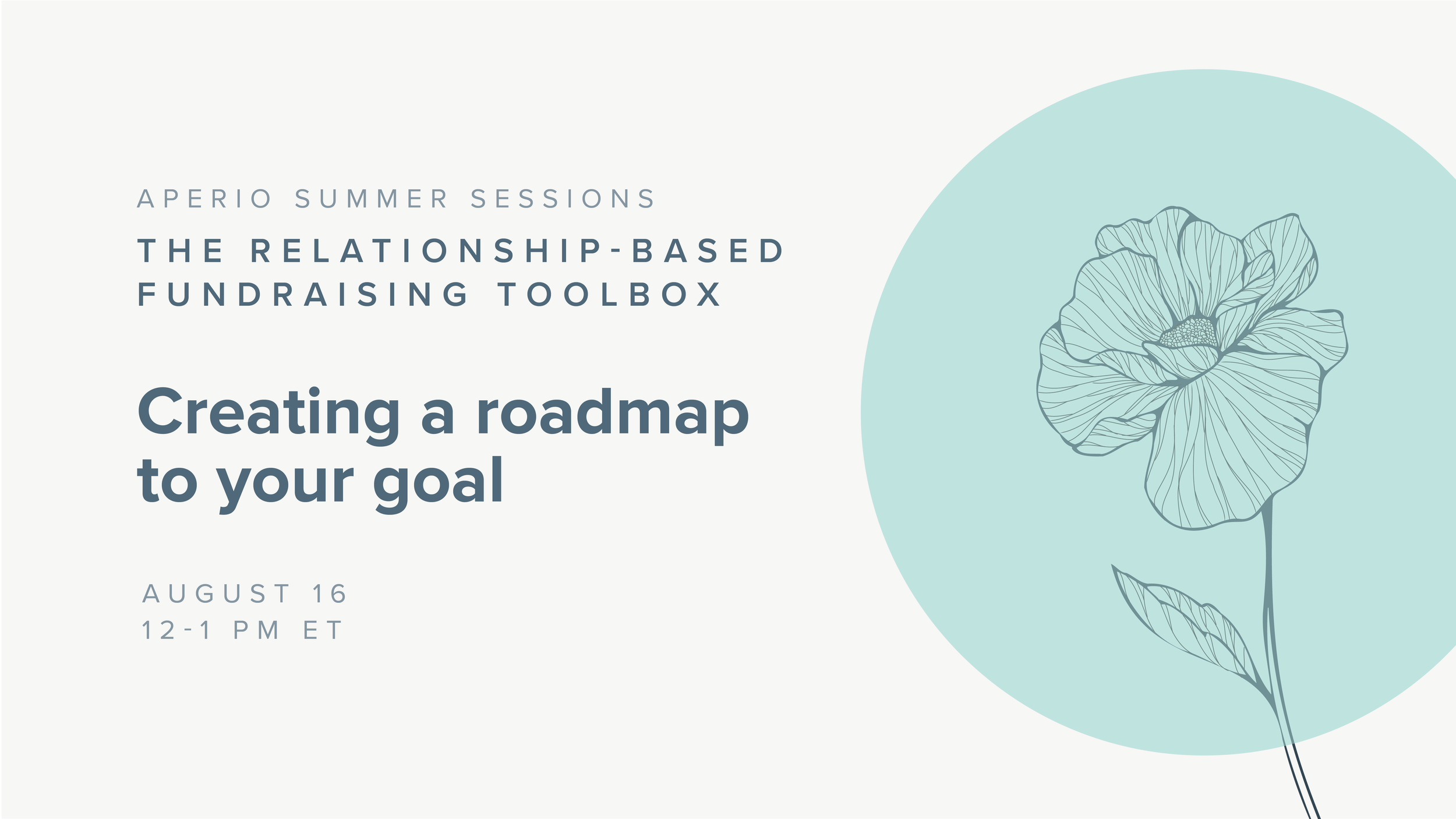Creating a roadmap to your goal · Aperio summer sessions: The relationship-based fundraising toolbox
This summer, Aperio hosted a three-part series on the fundamentals of relationship-based fundraising. When your team strategically invests in cultivating donor relationships, you’ll see increased donor loyalty, increased engagement, and increased revenue for your mission—all while making more efficient use of your team’s time and resources.
In these free, online lunchtime discussions, Kelly Braunegg and Toni Koch, both Senior Directors at Aperio, dove into the details on how to shift toward this simplified path for fundraising growth:
creating your donor engagement plan, and in this session,
developing a roadmap to your goal.
You can access the full event recordings for each of the sessions on YouTube. In this final session of the series, you’ll learn how to:
‘reverse-engineer’ a path to your goal,
create a shortlist of high potential donors to prioritize,
create ask plans for those donors, and
work those ask plans
‘Reverse-engineering’ a path to your goal
Reverse-engineering the path to your goal starts by knowing what your goal is—and understanding the donors in your organization’s database or in your portfolio. A donor pyramid can help. It’s a visual roadmap to your goal that breaks out the number of donors needed at each giving level. Creating a pyramid or gift table will allow you to:
Sort and prioritize donors by ask amount
Establish the number of asks you’ll need to make to reach your goal
Determine the number of donors you’ll need to engage to achieve your goal
Demonstrate to your team, leadership and board what it will take to meet the goal that’s been set
Identify whether additional resources or support will be needed to achieve the goal
Once we have determined the number of gifts we will need, we can reverse-engineer the rest of the path to our goal. From here, we’ll create a gift table to work out how many asks, meetings, and touchpoint will be needed to achieve the revenue goal.
Creating a shortlist
Once we know how we’re going to get to our goal, it’s time to determine who we will ask—to make a clear list of prospective donors to ask for major gifts this year. That shortlist should be made up of individuals and institutions with capacity to give large gifts. Any donor-facing fundraisers should spend 80% of their time building relationships with their personal “portfolio” of prospective supporters—meaning those with high philanthropic potential.
Everyone in a portfolio should have verified or suspected financial capacity to give at the major gifts level. But that’s just the starting point; we’re looking for someone who is high capacity and shows some other sign that we can build a relationship with them and at least get to a conversation about investing in our vision and mission. With that list in hand, you can begin assigning each donor to the appropriate members of your team. When assigning out donors, it’s important to keep bandwidth in mind. Portfolios that are too big often means donors get ignored or planned touchpoints don’t get out on time.
Planning the work
Now it’s time to map out an ask plan for each donor on your shortlist. Asks are at the heart of relationship-based fundraising. If you think about the donor cycle, we tend to use words like cultivation, stewardship, solicitation. Putting this jargon aside, what we’re really trying to do is spark a conversation, ask questions, and interest and inspire donors so that the ask becomes the natural next step in that conversation. At Aperio, we think about ask planning as defining the next ideal ‘destination' for each relationship with a prospective donor in your portfolio. As ask plan has four key elements:
The planned ask amount: Be bold in your ask, but don’t pull a number out of thin air! It should be based on what you know about the donor’s giving history, their capacity and any other known factors that might influence their giving this year.
The expected gift amount: Be realistic; consider last year’s giving history, the relationship status, and how engaged they are in your mission. This should be a conservative guestimate and it can absolutely be $0.
The planned ask date: This should be around 3 months before you expect to receive the gift.
The expected gift date: This could be based on last year’s gifts and/or conversations, where possible.
Working the plan
If the ask is your destination, then having a moves management plan is your route—it’s how you’re going to get to your ask. Moves management is more fundraising jargon for the steps you are going to take to engage donors in your mission and get them closer to an ask.
At Aperio, we talk a lot about keeping a 30–60–90-day line of sight on work. Being able to look about three months out is key to managing all the touchpoints and ask plans to reach your goal. The donor engagement plan we outlined in our previous session helps create that baseline experience for all of your donors, with the opportunity to layer on 1-to-1 touchpoints for personalized relationship management. Your CRM’s activity, action or task management functions will help you keep track of the day to day.
We are all prone to falling behind on our work. Sometimes staff turns over, or disasters strike, or life just happens, and we don’t get to everything on our long list of things to do. Some overdue asks and overdue expected gifts are inevitable.
Prioritize reaching out to donors to schedule meetings for those asks and thanking donors for gifts once they have been received.
—
You can access details and visuals for each of the steps we’ve summarized by watching the full event recording on YouTube. And, we invite you to join us for our next free, virtual online event for nonprofit leaders and fundraisers.


